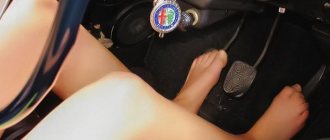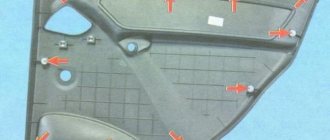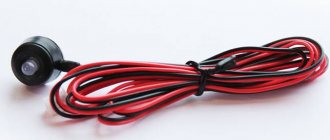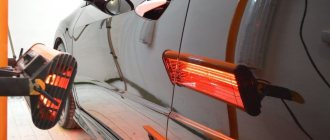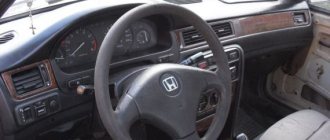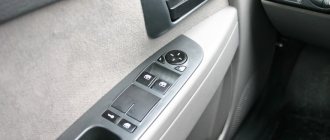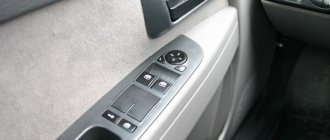What to do in case of skidding?
The most common cases are when the rear axle of a front-wheel drive car develops skidding. Here the front of the car continues to move in the same direction. At the same time, the rear wheels stop following. Thus, rotational movements occur, which intensify under the influence of centrifugal force.
You can correct the situation if you determine the reason for its development:
- sliding caused by too sharp a start, acceleration requires a reduction in speed - you need to stop pressing the gas;
- In situations caused by sudden braking, you need to stop pressing the brake.
These actions are aimed at reducing the dangerous effects of lateral forces.
To optimize the situation it is important:
- turn the steering wheel in the direction where the car is skidding; then the car will begin to turn in the opposite direction and will take its original position;
- you need to control the steering wheel evenly, ensuring a gradual return of the wheels to the desired position;
- To prevent a rear-wheel drive vehicle from skidding in the other direction, it is recommended to turn the steering wheel so that the angle is proportional to the amount of the current slip.
During operation, movements should be smooth so that the situation does not worsen to the point of developing a serious or rhythmic skid.
How to drive in the snow correctly
Virgin snow can become a good trap for a car if you drive through it without preliminary reconnaissance. It is best not to drive along it at all, but to look for a detour. But when there is no choice, but you need to drive, make sure that there is a hard surface under the snow, walk along the future route, checking if there are any obstacles, if the layer of snow is too thick, and if your car can cope with such a depth of cover. If nothing arouses suspicion, engage first gear and slowly, at a speed of 5-10 km/h, start driving. It is advisable to use snow chains, which should be in the trunk. If the car is stopped and does not move, turning its wheels in place, do not try to jerk forward a little more: this will cause more jamming. Engage reverse gear and, without changing the position of the steering wheel, try to drive back along your own track. If necessary, remove excess snow from under the wheels.
When driving in deep, loose snow, do not turn the front wheels at a large angle. With such a maneuver, the car, making forward motion straight, is carried forward by inertia, and the wheels are turned to the side. As a result, the sidewalls of the wheels create a snow parapet in front of them and rest against it. The lack of traction directed to the side prevents them from moving in the direction of the turn. To make a turn, tilt the steering wheel at small angles and turn along a large radius.
And one more thing... Many modern cars are equipped with special electronic systems that make driving on slippery surfaces and snow easier. If your car has such a system, it should only be used after you have carefully analyzed all its actions. To do this, in a closed area or a safe section of the road, experiment with different operating modes of the electronic assistant. Make the systems work by deliberately violating the above tips, but do everything at low speeds, no higher than 30 km/h.
Observe the car's reaction and behavior and decide whether, when, and in what modes to use electronic systems.
Pay attention to the terrain and terrain around you. For example, if the wooded part of the highway gives way to a swampy one, then, most likely, ice awaits you where moisture from a swamp or pond could remain on the surface
The spans of bridges, especially over non-freezing rivers, are also often covered with small drops of water, which freezes during a sharp cold snap, forming a very slippery crust.
Skidding of rear-wheel drive cars
It is not difficult to understand the reasons for the development of the situation. The problem is to learn how to get out of it, overcoming the fear that sometimes appears in the initial stages. The most difficult thing is to skid the rear axle of a rear-wheel drive car.
You can’t miss the moment here, you need to act immediately:
- When a skid develops, the rear of the car is pulled to the side, and the steering wheel turns in the same direction.
- Depending on the reason for the formation of such a situation, either the gas pedal or the brake is released.
- Next, you need to work the steering wheel until the rear of the car returns to its original position.
- At this point, the steering wheel should return to the position required for subsequent movement.
It is extremely undesirable, and even dangerous, during this period:
- use the handbrake;
- try to change gear;
- press on the brake.
All this leads to increased skidding and the development of a serious emergency situation.
Hard to learn, easy to fight
In order to increase your knowledge of control in such sudden situations, we recommend training. Of course, the site for such training must be chosen away from the city and with minimal vehicle traffic. This way you can conduct various experiments with drifts and control them. Also, for better assimilation, it is necessary to complicate the task and try to correct the situation with a controlled drift. And this is why the saying goes: “It’s hard to learn, but then it’s easy to fight.”
Skidding of front-wheel drive cars
When a front-wheel drive car skids when turning, it is worth considering the design feature.
Here the front wheels should pull the car, so you need to press on the gas, promoting an increase in speed. In this case, the driver must ensure that the front wheels do not spin.
Steps requiring attention:
- Without stopping to press on the gas, it is necessary to align the wheels in the front.
- Timely action when a car skids is extremely important. Therefore, a moment before the stern is returned to its original position, the rudder turns in the opposite direction.
- The steering wheel returns to its original position before the rear end stabilizes.
When the danger has passed, the speed decreases and normal movement continues.
Rules for fitting the seat and steering wheel
What to do if a front-wheel drive car skids? By not feeling the car's reaction due to an incorrect landing, you make the process of leveling the car much more difficult, since you do not have the opportunity to take effective actions during the skid. To prevent this from happening, try to follow these rules:
- 1. Fully depress the clutch so that your left leg is slightly bent at the knee and move the seat to such a distance as to maintain this position;
- 2. Select the desired seat angle so that, including the most distant gear, your back does not leave the seat;
- 3. Tilt the headrest to feel it with the back of your head, this, in addition to your safety, will help you better feel the reaction of the car;
Subtleties of output for all-wheel drive vehicles
Operating all-wheel drive models requires skills and knowledge of what to do when the car skids, since these situations are the most dangerous. Often the driver can only wait until the car stops. The type of all-wheel drive matters here. Also, most of it can be fed to a specific axis.
To prevent loss of control of the car, you should follow the recommendations:
- If this does happen, you should turn the steering wheel directly in the direction the car is skidding. The later the reaction, the faster you need to turn the steering wheel to stabilize the vehicle.
- Proper seating and the absence of sudden maneuvers while driving help prevent unforeseen situations.
- It is important not to release the gas, and pressing the brake pedal will make it impossible to maneuver further, which will aggravate the situation.
A situation such as a car skidding on the road is quite dangerous. But even worse is to succumb to fear. This is where mental toughness, experience and preparation go a long way. You can improve your skills by artificially creating drifts on areas or sections of the roadway where there are no other cars or pedestrians.
Why does loss of control occur?
Loss of traction between tires and road surface does not just happen. There are always reasons for a car skidding, which are represented by mistakes, making wrong decisions while driving.
- Skidding when pressing the gas or braking is common. The solution is to stop pressing the gas or brake pedal and continue maneuvering.
- Loss of control when entering a turn occurs as a result of:
- sharp turn of the steering wheel;
- cornering at high speed;
- sharply pressing or releasing the gas pedal when performing a maneuver;
- a strong, sudden application of the brake.
In winter, when the road is slippery, any sudden maneuver or movement of the driver leads to loss of control.
The following road sections require special attention:
- turns in places with serious unevenness;
- steep descents;
- zones of forced movement on a slope.
Correct sitting, accompanied by a tight fit of your back to the seat, allows you to sense a loss of control in time and take measures to restore safety. This approach will allow you to learn how to identify drifts at the initial stage and quickly get out of them.
Basic recommendations
Some drivers are confident that after studying the theory of skidding and getting out of them, they know exactly how to act correctly, and this will not happen to them.
But practice shows that the driver is already dooming himself to loss of control just after he gets behind the wheel. There are basic rules that drivers forget about. It is their violation that does not allow you to apply all your theoretical skills.
Landing. The driver must take the most comfortable position in the vehicle. It’s not for nothing that modern cars are equipped with special drives and levers that allow you to adjust the chair to your height, weight, arm length and a number of other parameters. This is a matter of not only comfort, but also safety. The more comfortable the driver is, the less he will be distracted by back pain or numb hands. Therefore, the main attention is paid to the situation on the road. Hand position. Everyone needs to get rid of this pretentious habit of driving the steering wheel with one hand at once. Yes, if you are standing in a traffic jam and gradually moving, having an automatic transmission at your disposal, then steering with one hand is still allowed. But when you are moving at high speed, on a bad road, both hands must be on the steering wheel. Moreover, they should be positioned as conveniently and correctly as possible.
To regain control in a skid, every moment counts. And if your hands are positioned incorrectly, you simply will not be able to turn at the right moment and to the required degree. Concentration
When the road is slippery and visibility is poor, you should never be distracted from managing and monitoring the traffic situation. Try to concentrate. Then you will significantly reduce the likelihood of losing control.
Start with these basic tips. If you adhere to them, then the likelihood of entering an uncontrolled skid will be significantly reduced.
Front-wheel drive skidding
To get a front-wheel drive car out of a skid, a beginner may well limit himself to the same actions as in the previous case, only instead of engine braking, he needs to slightly increase the speed. As for an experienced driver with solid driving experience, he will most likely be able to pull the car out of a skid exceeding ninety degrees without loss.
At the moment when you feel the beginning of a skid, simultaneously with turning the steering wheel, smoothly press the gas pedal and hold it.
Moreover, you should hold it until the skidding angle decreases. After this, the gas pedal should be released and the steering wheel should be kept straight.

